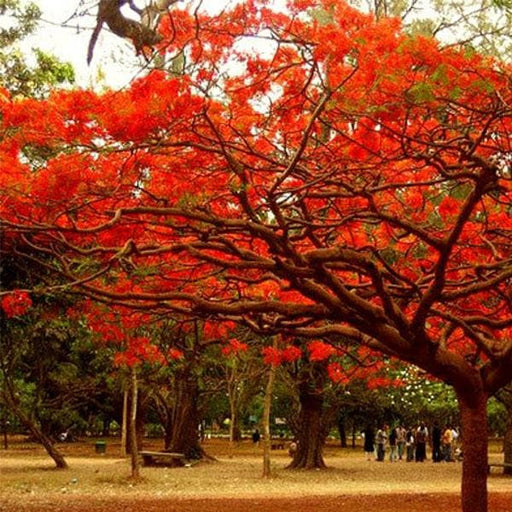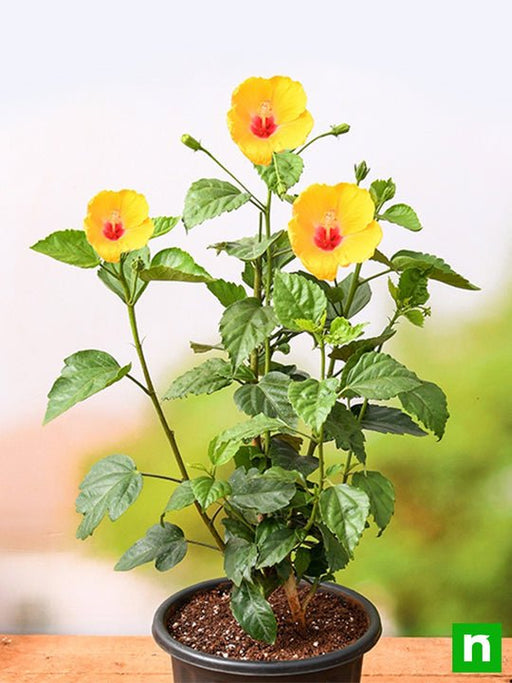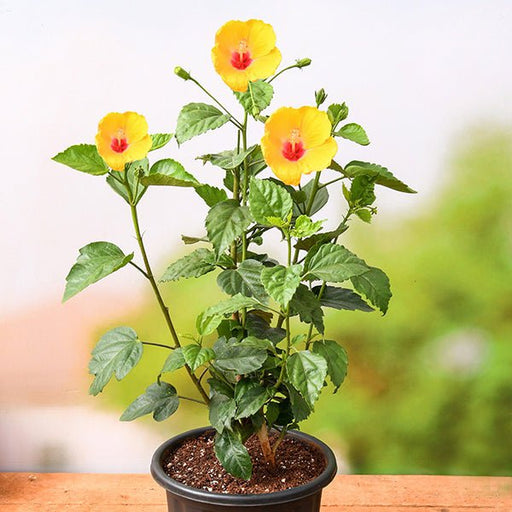
Fittonia Albivenis, Red Nerve Plant - Plant
(MRP Inclusive of all taxes)
- Shipping ₹79 for entire order
- Dispatch in 7 days
- Country of origin: India

(MRP Inclusive of all taxes)

 Save 25%
Save 25%
Rose (Red) - Plant The Red Rose (Rosa rubiginosa) is a timeless symbol of love and passion, renowned for its stunning blooms and enchanting fragra...
View full details Save 25%
Save 25%
Hibiscus, Gudhal Flower (Red Double) - Plant The Hibiscus, also known as Gudhal Flower, is a stunning ornamental plant that boasts vibrant...
View full details
 Save 25%
Save 25%
Hibiscus, Gudhal Flower (Red) - Plant The Hibiscus, commonly known as Gudhal Flower, is a stunning tropical plant renowned for its vibrant red blo...
View full details
 Save 17%
Save 17%
Miniature Rose, Button Rose (Red) - Plant The Miniature Rose, also known as the Button Rose, is a stunningly beautiful plant that brings a touch o...
View full details Save 26%
Save 26%
Russelia (Red) - Plant The Russelia (Red), commonly known as the Firecracker Plant, is a stunning perennial that captivates with its vibra...
View full details Save 18%
Save 18%
Gulmohar Tree, Delonix regia - Plant The Gulmohar Tree, scientifically known as Delonix regia, is a stunning tropical tree renowned for it...
View full details
 Save 25%
Save 25%
Hibiscus, Gudhal Flower (Yellow Red) - Plant The Hibiscus, commonly known as Gudhal, is a stunning flowering plant that captivates with it...
View full details Save 15%
Save 15%
Pack of Vermicompost and Neem Cake for House Plants Transform your indoor garden with our premium Pack of Vermicompost and Neem Cake, spec...
View full details
Pack of Plant Growth and Flower Boosters Unlock the full potential of your garden with our Pack of Plant Growth and Flower Boosters! This ...
View full details Save 38%
Save 38%
Combo of Jeevamrut and Neem Raksha for Easy Growth and Protection of Houseplants Transform your indoor garden with our exclusive combo of ...
View full details Save 22%
Save 22%
Plant Nutrients Kit (Pack of 16) for a Healthy Garden Transform your garden into a lush paradise with our Plant Nutrients Kit, featuring 1...
View full details Save 16%
Save 16%
Combo of Top Plant Fertilizers Elevate your gardening game with our exclusive Combo of Top Plant Fertilizers, featuring two bags of premiu...
View full details Save 24%
Save 24%
Pack of 4 Additives to Make Soil Healthy and Nutrient Rich Transform your garden into a thriving ecosystem with our Pack of 4 Additives de...
View full details Save 30%
Save 30%
Transform your gardening experience with our premium Combo of Perlite and Vermiculite. This unique blend is designed to enhance soil aeration and ...
View full details Save 27%
Save 27%
Combo of 2 Vermicompost and Cocopeat - Enrich Your Soil Naturally! Transform your garden into a thriving ecosystem with our Combo of 2 Ver...
View full details
 Save 35%
Save 35%
Best 6 Plants for Perfect Indoor Garden Transform your living space into a lush oasis with our curated collection of the Best 6 Plants for a...
View full details
 Save up to 50%
Save up to 50%
Mini Succulent Garden Pack Transform your space with our Mini Succulent Garden Pack, featuring a delightful collection of 4 any variety beautiful s...
View full details
 Save 30%
Save 30%
5 Best Fragrant Plants Transform your garden or indoor space into a fragrant paradise with our curated selection of the 5 Best Fragrant Plants. Th...
View full details
 Save 24%
Save 24%
Set of 2 Bonsai Looking Grafted Adeniums Transform your indoor or outdoor space with our exquisite Set of 2 Bonsai Looking Grafted Adenium...
View full details Save 45%
Save 45%
Top 4 Die Hard Succulents Pack Transform your indoor or outdoor space with our Top 4 Die Hard Succulents Pack, featuring a curated selecti...
View full details
 Save 30%
Save 30%
5 Best Indoor Plants Pack Transform your living space into a lush oasis with our '5 Best Indoor Plants Pack.' This carefully curated collection fe...
View full details
 Save 25%
Save 25%
Set of 4 Evergreen Air Purifier Plant Pack Transform your indoor space into a lush, green oasis with our Set of 4 Evergreen Air Purifier Pla...
View full details| SrNo | Item Name | Qty |
|---|---|---|
| 1 | Fittonia Albivenis, Red Nerve Plant in 4 inch (10 cm) Pot | 1 |
| 2 | 4.5 inch (11 cm) Ronda No. 1110 Round Plastic Planter (Red) | 1 |
The Fittonia Albivenis, commonly known as the Red Nerve Plant, is a stunning houseplant celebrated for its vibrant foliage and unique veining. Native to the tropical rainforests of South America, this low-growing perennial thrives in humid environments, making it a perfect addition to your indoor garden. Its striking red and green leaves not only add a pop of color to any space but also purify the air, contributing to a healthier living environment.
What makes the Fittonia Albivenis special is its ability to adapt to various light conditions while maintaining its vivid colors. This resilient plant is an excellent choice for both novice and experienced plant enthusiasts. Its intricate leaf patterns and lush growth make it a captivating focal point in any room, enhancing your home decor with a touch of nature.
One of the standout features of the Red Nerve Plant is its unique ability to thrive in low-light conditions, making it an ideal choice for indoor spaces. Additionally, its humidity-loving nature allows it to flourish in terrariums or as part of a larger indoor garden, creating a lush, tropical atmosphere.
If you think caring for a plant is as easy as watering it and giving it a pep talk, think again! The Fittonia Albivenis, or Red Nerve Plant, is a diva that demands attention. It thrives in high humidity and indirect light, so if your home resembles a desert, it might be time to invest in a humidifier. Keep the soil moist but not soggy, and watch as this beauty rewards you with vibrant leaves that scream, "Look at me!"
Want to multiply your plant family? Propagating Fittonia Albivenis is like playing plant matchmaker. Snip a healthy stem, pop it in water, and wait for roots to emerge. It’s like a reality show for plants—will they find love or wilt in despair? Once rooted, transfer them to soil, and voilà! You’ve got yourself a mini jungle.
The Red Nerve Plant is a bit of a light snob. It prefers bright, indirect sunlight, so don’t even think about placing it in direct sun—unless you want to witness a dramatic leaf meltdown. Think of it as a plant that enjoys a cozy café ambiance rather than a scorching beach day.
The right soil is crucial for your Fittonia Albivenis to thrive. It craves well-draining, rich potting mix that retains moisture without turning into a swamp. A blend of peat, perlite, and vermiculite is like a five-star buffet for your plant. Remember, happy roots equal happy leaves!
If you want your Fittonia Albivenis to flourish, you better bring the humidity! This plant is native to tropical rainforests, so it thrives in a moist environment. If your home is drier than a bone, consider misting it regularly or placing it on a pebble tray filled with water. Your plant will thank you with lush, vibrant foliage.
Fertilizing your Fittonia Albivenis is like giving it a spa day. During the growing season, a diluted liquid fertilizer every month will keep it looking fabulous. Just remember, too much of a good thing can lead to a plant hangover—so don’t overdo it!
Beware, the Red Nerve Plant can attract pests like spider mites and aphids. It’s like a magnet for unwanted guests! Regularly inspect your plant and give it a gentle wash to keep those pesky critters at bay. If they do crash the party, a little neem oil can send them packing.
Good news for pet lovers! Fittonia Albivenis is non-toxic to cats and dogs. So, while your furry friends may be tempted to nibble on those colorful leaves, you can rest easy knowing they won’t face any plant-related drama.
The world of Fittonia Albivenis is a colorful one! While the Red Nerve Plant is a showstopper, there are other varieties with different leaf patterns and colors. Explore the green, pink, and white options to create a vibrant plant collection that will make your friends green with envy.
Repotting your Fittonia Albivenis is like giving it a new apartment. Choose a pot that’s just a size bigger, and make sure it has drainage holes. Gently loosen the roots and place it in fresh soil. Your plant will feel like it’s moved from a studio to a penthouse!
Beyond its stunning appearance, the Fittonia Albivenis offers air-purifying benefits. It’s like having a tiny environmental superhero in your home, working tirelessly to improve air quality while looking fabulous. Who knew a plant could be both a beauty and a brain?
As the seasons change, so do the needs of your Fittonia Albivenis. In winter, it may require less water and a bit more warmth. Keep an eye on its leaves—if they start drooping, it’s time to adjust your care routine. Think of it as a seasonal wardrobe change for your plant!
Fittonia Albivenis, also known as the Red Nerve Plant, is a vibrant houseplant with striking red veins on its leaves. It’s like nature’s own artwork, perfect for adding a splash of color to your indoor jungle. Plus, it’s a low-maintenance diva that thrives in humidity, making it a favorite among plant parents.
Caring for your Fittonia Albivenis is as easy as pie—if pie were a humidity-loving plant! Keep it in bright, indirect light, water when the top inch of soil is dry, and maintain humidity levels. Think of it as a tropical vacation for your plant, minus the sunscreen and beach towels.
The Red Nerve Plant prefers bright, indirect light, like a diva basking in the spotlight without the harsh glare. Too much direct sunlight can scorch those beautiful leaves, while too little can make them sulk. Aim for a cozy spot near a window, and watch your plant thrive like it’s on a sun-soaked holiday.
Water your Fittonia Albivenis when the top inch of soil feels dry—think of it as giving your plant a refreshing drink after a long day. Typically, this means watering once a week, but it’s always good to check. Overwatering is a no-no; we don’t want your plant to feel like it’s swimming in a pool!
Good news for pet parents! Fittonia Albivenis is non-toxic to cats and dogs, so you can enjoy its beauty without worrying about your furry friends. Just keep it out of their reach, as curious critters might still want to nibble on those colorful leaves. After all, who can resist a plant that looks like candy
Fittonia Albivenis loves a cozy environment, thriving in temperatures between 65°F to 80°F. It’s not a fan of cold drafts or sudden temperature changes, so keep it away from windows that open in winter. Think of it as your plant’s personal spa—warm, inviting, and just the right amount of pampering.
Absolutely! Propagating your Fittonia Albivenis is like sharing the love. Simply take a cutting with a few leaves, place it in water or moist soil, and watch it grow roots. It’s a fun little project that can turn your single plant into a whole family of vibrant nerve plants. Who doesn’t love a plant party
Your Fittonia Albivenis might attract pests like spider mites or mealybugs, but don’t panic! Regularly check for these uninvited guests and wipe them off with a damp cloth or insecticidal soap. Think of it as giving your plant a spa day—clean, refreshed, and ready to show off those stunning leaves!
Fertilizing your Fittonia Albivenis is like giving it a gourmet meal. Use a balanced liquid fertilizer every 4-6 weeks during the growing season. Just dilute it to half strength, and your plant will be thanking you with vibrant growth and those eye-catching red veins. Bon appétit, little plant!
Yellowing leaves on your Fittonia Albivenis could mean it’s feeling a bit too thirsty or too dry. Check your watering routine—overwatering can lead to root rot, while underwatering can leave it parched. Adjust your care, and soon those leaves will be back to their vibrant selves, ready to strut their stuff!
To boost humidity for your Fittonia Albivenis, consider misting it regularly, placing it on a pebble tray with water, or using a humidifier. It’s like throwing a tropical party for your plant! Higher humidity levels will keep those leaves lush and vibrant, ensuring your plant feels like it’s on a permanent vacation.